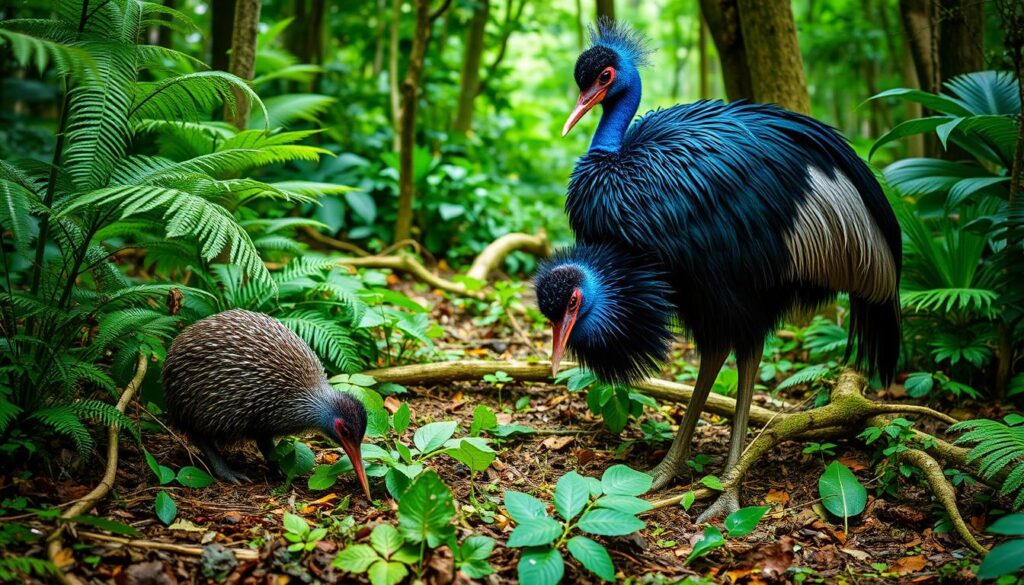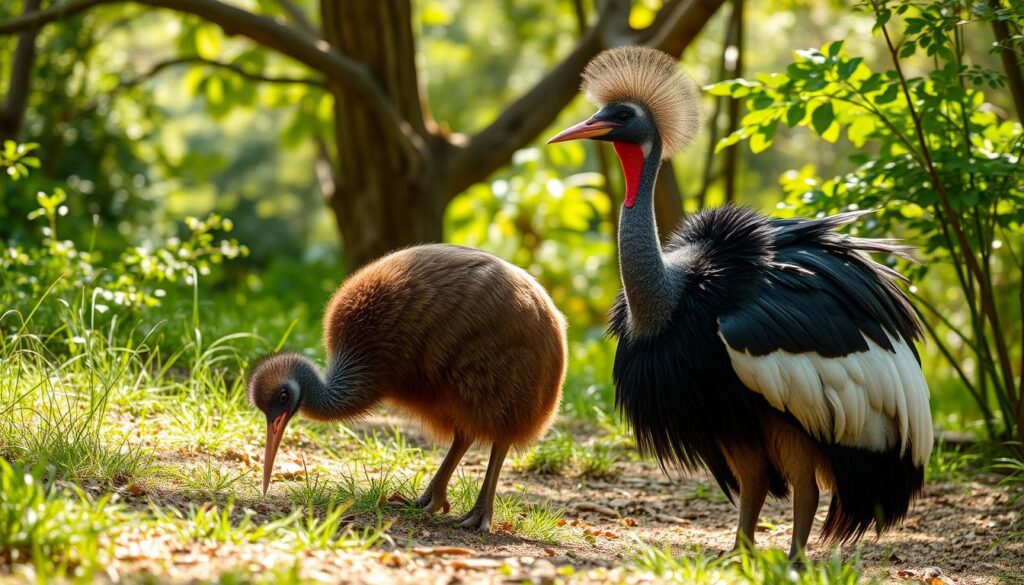Ratites are a fascinating group of flightless birds. They include ostriches, emus, rheas, cassowaries, and kiwis.
These birds belong to the infraclass Palaeognathae. Their unique lineage has intrigued evolutionary biologists for years.
Recent genetic studies have challenged old theories about ratites. They suggest these birds may have evolved from flying ancestors.
The evolution of ratites has sparked much debate. New findings reveal complex relationships within this diverse group.
Flightless birds have unique traits that help them thrive on land. We’ll explore these adaptations in cassowaries and kiwis.
An Introduction to Flightless Birds
Flightless birds, known as ratites, lack a keel on their sternum. This makes them different from birds that can fly.
The paleognath group includes flightless ratites and flying tinamous. Studies show tinamous fit within the ratite family tree.
This suggests flightless birds may have evolved separately many times.
These ground-dwelling birds live in parts of the old supercontinent Gondwana. Fossils have also been found in Europe and possibly North America.
Their spread and history fascinate scientists. It shows how these birds adapted to life on land.
Overview of the Kiwi
Kiwis are small flightless birds from New Zealand. They belong to the ratite group and have five species.
Kiwis are chicken-sized, shy, and active at night. They have an amazing sense of smell, unlike other birds.
Kiwi eggs are huge compared to the bird’s size. They can weigh up to 25% of the female’s body weight.
This helps kiwi chicks hatch well-developed. It gives them a better chance to survive in New Zealand’s tough environment.
The little spotted kiwi is the smallest type. It weighs 0.9 to 1.9 kilograms and is 35 to 45 centimeters long.
These New Zealand birds are hard to spot. They’re shy and hide well, making them exciting for bird lovers.
Kiwis are a symbol of New Zealand. They’re very important to the Maori people.
The kiwi species has a unique history. Their special features make them fun to learn about.
Overview of the Cassowary
Cassowaries are powerful Australian birds native to tropical forests. These flightless marvels can reach 1.8 meters tall and weigh up to 85 kilograms.
Cassowaries thrive in dense, lush forests with razor-sharp talons. They’re among the world’s most dangerous birds, capable of inflicting serious injury.
In New Guinea, locals prize cassowary chicks as a delicacy. This shows the bird’s cultural importance in the region.
Cassowaries are related to kiwis and extinct elephant birds. A University of Adelaide study revealed their fascinating evolutionary origins.
Comparison of Kiwi and Cassowary Behavior
Kiwis and cassowaries are two unique flightless birds. They have different behaviors shaped by their homes and diets.
Kiwis come out at night to find food. They use their good sense of smell to find bugs in the soil.
Kiwis make nests in deep holes. These holes keep their eggs and babies safe.
Cassowaries live in sunny forests in Australia and New Guinea. They have strong legs and can be mean if you get too close.
Both birds have special ways to live in their homes. Kiwis can smell well to move in dark places.
Cassowaries have big claws to walk through thick plants. They use these claws to protect their space too.
These birds’ special traits help them stay alive. Many people love to learn about these amazing birds.
Conservation Status of Kiwis and Cassowaries
Kiwis and cassowaries face big threats to their survival. Habitat loss and human activity are the main reasons for their decline.
Kiwi numbers in New Zealand have dropped by 99% since humans arrived. They’re listed as “vulnerable” on the IUCN Red List.
Predators like stoats and possums hurt kiwi populations. Loss of forest homes also affects them badly.
Conservation efforts help stabilize kiwi numbers. About 40 chicks hatch each year in special facilities.
Cassowaries are in worse shape, listed as “endangered” by the IUCN. They live in tropical forests of Australia and New Guinea.
Human development hurts cassowaries’ homes. They often crash into cars on roads through forests.
Cassowaries are important seed spreaders. One bird can spread about 20,000 seeds per year.
Only 1,500 to 2,000 cassowaries remain in the wild. This low number is very worrying.
Saving kiwis and cassowaries means protecting their homes. It also involves controlling predators and teaching people about these birds.
The fate of these birds shows how human actions affect nature. We must act to save these unique flightless birds.
How Kiwis and Cassowaries Adapted to Life on the Ground
Kiwis and cassowaries are flightless birds with cool changes. They look alike but aren’t close family.
These birds can’t fly, so they grew strong legs. Their bones got tougher to help them live on land.

Losing flight is easy when living on the ground is better. Kiwis and cassowaries changed their bodies and how they act.
The Cultural Significance of Kiwis and Cassowaries
Kiwis are flightless birds that symbolize New Zealand’s identity. They represent the country’s unique wildlife and resilience.
Kiwis are important in Māori culture. They appear in traditional stories, art, and customs.
Cassowaries are large birds found in Australia and nearby islands. Many Aboriginal and Torres Strait Islander communities revere them.
Cassowaries help maintain healthy tropical forests. They do this by spreading seeds and performing other ecological tasks.
Both kiwis and cassowaries are symbols of conservation. Efforts to protect these birds have raised awareness about wildlife protection.
These flightless birds are more than unique species. They are vital parts of their homelands’ natural and cultural heritage.
FAQ
What is the significance of ratites in the evolutionary history of birds?
Ratites are flightless birds in the Palaeognathae infraclass. They evolved from flying ancestors, losing flight many times.
This challenges the “out-of-Gondwana” theory. Genetic evidence supports this new understanding.
How are ratites and tinamous related?
Paleognaths include flightless ratites and flying tinamous. Studies show tinamous are part of the ratite family tree.
This suggests flightlessness evolved several times on its own. It’s a new view of bird evolution.
What are the unique characteristics of kiwis?
Kiwis are small, shy, nocturnal birds from New Zealand. They have a strong sense of smell and lay very large eggs.
The little spotted kiwi is the smallest. It weighs between 0.9 to 1.9 kilograms.
What are the distinctive features of cassowaries?
Cassowaries live in Australia and nearby islands. They are shorter than emus but heavier, living in thick tropical forests.
They have sharp talons and can be dangerous. Cassowaries can grow up to 1.8 meters tall and weigh 85 kilograms.
How do kiwis and cassowaries differ in their behavior and adaptations?
Kiwis are active at night and use smell to find food. They nest in deep burrows.
Cassowaries are active during the day in tropical forests. They have strong legs and can be aggressive.
What are the conservation challenges facing kiwis and cassowaries?
Kiwis face threats from predators and habitat loss in New Zealand. Cassowaries are at risk from habitat loss in Australia and New Guinea.
Conservation efforts include protecting habitats, controlling predators, and breeding programs. These aim to save both species.
How have kiwis and cassowaries adapted to a ground-dwelling lifestyle?
Kiwis and cassowaries lost flight and developed strong legs. Their skeletons changed to suit life on the ground.
These changes hide their true genetic links. Losing flight seems to happen easily when helpful.
What is the cultural significance of kiwis and cassowaries?
Kiwis are a national symbol of New Zealand. Cassowaries are important in Australian and New Guinea cultures.
Both birds represent conservation efforts. They raise awareness about protecting native wildlife and habitats.


